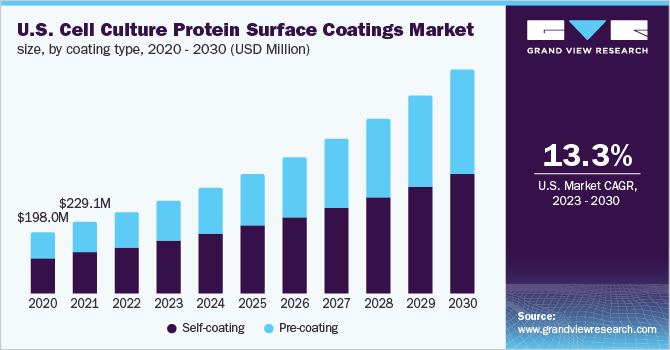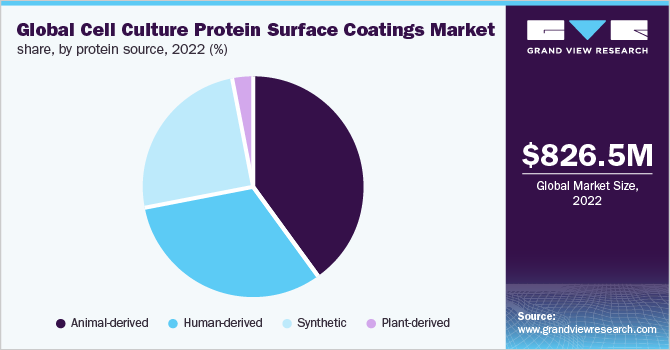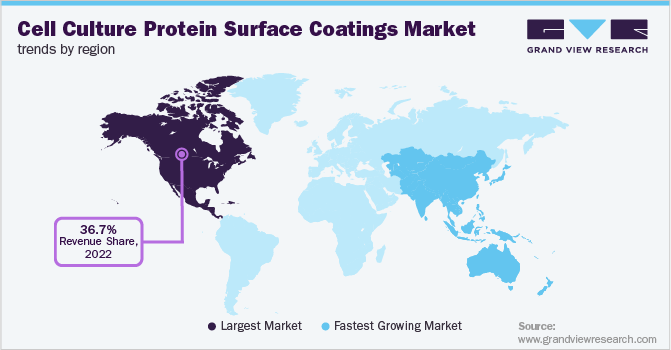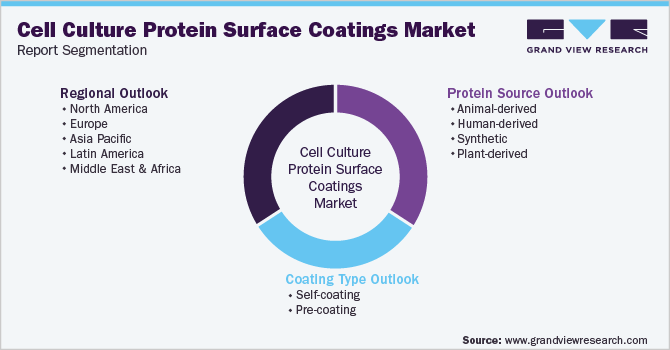- Home
- »
- Biotechnology
- »
-
Cell Culture Protein Surface Coatings Market Size Report 2030GVR Report cover
![Cell Culture Protein Surface Coatings Market Size, Share & Trends Report]()
Cell Culture Protein Surface Coatings Market (2023 - 2030) Size, Share & Trends Analysis Report By Coating Type (Self-coating, Pre-coating), By Protein Source (Animal-derived, Synthetic), By Region, And Segment Forecasts
- Report ID: GVR-1-68038-719-3
- Number of Report Pages: 120
- Format: PDF
- Historical Range: 2018 - 2021
- Forecast Period: 2023 - 2030
- Industry: Healthcare
- Report Summary
- Table of Contents
- Segmentation
- Methodology
- Download FREE Sample
-
Download Sample Report
Report Overview
The global cell culture protein surface coatings market size was valued at USD 826.5 million in 2022 and is expected to expand at a compound annual growth rate (CAGR) of 15.29% from 2023 to 2030. The increasing interest of scientists and biotechnology companies in stem cell research is a major factor driving the industry growth. Cell culture protein surface coating provides improved development and cell adhesion in in-vitro cell culture. Thus, the demand for these products is increasing, thus creating revenue generation opportunities. A stem cell is a very effective and promising therapy to treat several severe diseases including neurological diseases, cancer, Cardiovascular Diseases (CVDs), and cell deficiency.

For instance, Parkinson's and Alzheimer's disease can be treated by replacing damaged cells and tissues. In the context of COVID-19, various government organizations, research institutes, and pharmaceutical & biotech firms are focusing on rapid and effective technologies for developing vaccines/novel therapeutics and diagnosis of COVID-19 to overcome the situation. For instance, researchers from UVE (Unité des Virus Émergents) screened 1,520 USFD-approved drugs for their anti-viral properties using Caco-2 and VeroE6 immortalized cell lines. From this study, researchers recognized 90 compounds spanning distinct drug categories, such as proton pump inhibitors and antibiotics that might be therapeutically relevant to treat COVID-19.
Similarly, researchers from the Institute for Molecular Medicine Finland made use of VeroE6 cell lines and found that a combination of host-directed amodiaquine and orally available virus-directed nelfinavir unveiled the finest therapeutic effects against COVID-19 across 136 broad range antiviral products. Such developments significantly increased the demand for culture products during the COVID-19 pandemic. The rising interest of researchers and biotechnology companies in stem cell research is one of the key factors driving the industry's growth. Stem cells have become a potential tool for the treatment of several disorders, such as osteoarthritis, heart failure, and eye diseases.
Regenerative medicine has revolutionized research in science and technology by growing entirely new organs and tissues outside the body by taking cells from patients. This would further increase the demand for regenerative medicine for the treatment of diseases. With constant development in therapies, several new advanced cell culture protein surfaces have emerged. Advancements in the research and development field would further fuel industry growth in the coming years. The protein surfaces offer better growth and adhesion in cell culture. Gelatin is usually used in the culture of muscle, Embryonic Stem (ES) cells, and vascular endothelial cells, among others.
Corning Inc., one of the leading players, offers a wide range of cell culture protein surfaces and substrates, which enable cell attachment under difficult conditions. For instance, the company offers BioCoat Gelatin culture ware, which offers attachment and growth-promoting substrate for the culture. Moreover, in the past few years, cell culture has evolved and is widely used as a bioproduction and research tool. The protein surfaces used for growing cells have progressed rapidly, as the need for researchers has changed. Several breakthrough studies have helped with the advancement of the culture medium, resulting in a significant rise in the use of cell culture.
The other drivers include the growing demand for targeted therapy and protein therapeutics along with an increasing preference for 2D and 3D cell cultures. 3D cell culture is a process of growing biological cells in a controlled condition, where cells could interact with the surrounding cells across all dimensions. The protein-coated instruments offer a 3D microenvironment to attain proper proliferation and cell adhesion. For instance, Agilent Technologies offers automated imaging tools that could provide significant information to improve routine culture techniques and increase the reproducibility and effectiveness of downstream cell-based assays.
Coating Type Insights
Based on coating types, the global industry has been further segmented into pre-coating and self-coating. In 2022, the self-coating segment dominated the global industry and accounted for the highest share of around 60.27% of the overall revenue. The rising investment in research and development is a key factor boosting segment growth. The biotechnology and biopharmaceutical companies are focusing on the production of monoclonal antibodies, protein therapeutics, induced pluripotent stem cell research, and cryobanking. Thus, the demand for self-coating is also expected to remain high during the study period.
On the other hand, the pre-coating segment is expected to register the fastest growth rate during the forecast period. This segment is further classified into multiwall/microwell plates, flasks, Petri dishes, slides, and cover slips. The precoated culturewares provides several advantages, such as it is ready-to-use, saving time, delivering consistent quality, and improving isolation and cultivation. Thus, the popularity of pre-coating culturewares is increasing. This, in turn, is projected to boost the growth of the pre-coating segment.
Protein Source Insights
Based on protein sources, the global industry has been further categorized into animal-derived, human-derived, synthetic, and plant-derived proteins. The animal-derived material segment dominated the global industry in 2022 and accounted for the highest share of 40.16% of the overall revenue. The major application of these products in the production of biopharmaceuticals including monoclonal antibodies and recombinant proteins is the most predominant factor contributing to its highest share. On the other hand, the demand for human-derived protein products is also high due to their large application in insulin production.

The increasing incidence of diabetes drives the demand for insulin. Thus, the rising incidence of diabetes boosts the growth of the human-derived protein segment. On the other hand, the synthetic material segment is expected to exhibit the fastest growth rate during the forecast period. The growing demand for animal-free components is a prime factor attributing to the growth of this segment. Ethical and religious constraints on the application of animal-derived protein propel the adoption of synthetic protein coatings.
Regional Insights
North America dominated the overall industry and accounted for the largest share of 36.68% in 2022. The highly developed healthcare & research infrastructure and focus on drug discovery in the region have fueled the region’s growth. The U.S. dominated the regional market of North America owing to the rapid technological advancements, increasing approval for cell culture-based vaccines, growth in pharmaceutical and biotechnology industries, strong government support, high funding in cell-based research, and growing incidence of diseases, such as cancer. For instance, in May 2022, Blue Water Vaccines, Inc. collaborated with the multidisciplinary Center for Research and Development in Immunobiologics, which aims to develop influenza vaccine candidates based on cell culture and adjuvant formulation-based vaccines.

Asia Pacific is expected to register the fastest CAGR during the study period due to untapped opportunities in the region. China is anticipated to witness significant growth in the coming years owing to the presence of several biopharmaceutical companies and clinical research organizations in the country working towards drug discovery and development. The untapped opportunities in the country are attracting international players to invest in the country’s market. For instance, in October 2020, Merck KGaA collaborated with D1Med a Shanghai-based biopharmaceutical company, that aims to advance the 3D cell culture technology in China, which could be used in the drug discovery process. Moreover, with favorable government policies and growing R&D investments, the country is witnessing a surge of innovative biotech and pharma companies.
Key Companies & Market Share Insights
Key players are adopting various organic and inorganic strategies, such as partnerships, mergers and acquisitions, geographical expansion, and strategic collaborations to expand their industry presence. For instance, in January 2022, Thermo Fisher Scientific Inc. acquired PeproTech. PeproTech’s recombinant protein range complements the cell culture products of Thermo Fisher and will allow Thermo Fisher to offer customers substantial benefits through a combined offering. Some of the key players in the global cell culture protein surface coatings market include:
-
Thermo Fisher Scientific, Inc.
-
Corning Incorporated
-
Merck KGaA
-
Eppendorf SE
-
Sartorius AG
-
Greiner Bio-One International GmbH
-
PerkinElmer, Inc.
-
ZenBio, Inc.
-
Kollodis BioSciences, Inc.
-
Viogene
Cell Culture Protein Surface Coatings Report Scope
Report Attribute
Details
Market size value in 2023
USD 951.3 million
Revenue forecast in 2030
USD 2,575.0 million
Growth rate
CAGR of 15.29% from 2023 to 2030
Base year for estimation
2022
Historical data
2018 - 2021
Forecast period
2023 - 2030
Quantitative units
Revenue in USD million and CAGR from 2023 to 2030
Report coverage
Revenue forecast, company ranking, competitive landscape, growth factors, and trends
Segments covered
Coating type, protein source, region
Regional scope
North America; Europe; Asia Pacific; Latin America; Middle East & Africa
Country scope
U.S.; Canada; U.K.; Germany; France; Italy; Spain; Denmark; Sweden; Norway; Japan; China; India; Australia; Thailand; South Korea; Brazil; Mexico; Argentina; South Africa; Saudi Arabia; UAE; Kuwait
Key companies profiled
Thermo Fisher Scientific, Inc.; Corning Incorporated; Merck KGaA; Eppendorf SE; Sartorius AG; Greiner Bio-One International GmbH; PerkinElmer, Inc.; ZenBio, Inc.; Kollodis BioSciences, Inc.; Viogene
Customization scope
Free report customization (equivalent up to 8 analyst’s working days) with purchase. Addition or alteration to country, regional, and segment scope.
Pricing and purchase options
Avail customized purchase options to meet your exact research needs. Explore purchase options
Global Cell Culture Protein Surface Coatings Market Segmentation
This report forecasts revenue growth at global, regional, and country levels and provides an analysis of the latest industry trends in each of the sub-segments from 2018 to 2030. For this study, Grand View Research has segmented the global cell culture protein surface coatings market report based on coating type, protein source, and region:

-
Coating Type Outlook (Revenue, USD Million, 2018 - 2030)
-
Self-coating
-
Pre-coating
-
Multiwall/microwell plates
-
Petri dishes
-
Flasks
-
Slides
-
Cover slips
-
-
-
Protein Source Outlook (Revenue, USD Million, 2018 - 2030)
-
Animal-derived
-
Human-derived
-
Synthetic
-
Plant-derived
-
-
Regional Outlook (Revenue, USD Million, 2018 - 2030)
-
North America
-
U.S.
-
Canada
-
-
Europe
-
UK
-
Germany
-
France
-
Italy
-
Spain
-
Denmark
-
Sweden
-
Norway
-
-
Asia Pacific
-
Japan
-
China
-
India
-
Australia
-
Thailand
-
South Korea
-
-
Latin America
-
Brazil
-
Mexico
-
Argentina
-
-
Middle East & Africa
-
South Africa
-
Saudi Arabia
-
UAE
-
Kuwait
-
-
Frequently Asked Questions About This Report
b. The global cell culture protein surface coatings market size was estimated at USD 826.5 million in 2022 and is expected to reach USD 951.3 million in 2023.
b. The global cell culture protein surface coatings market is expected to grow at a compound annual growth rate of 15.29% from 2023 to 2030 to reach USD 2,575.0 million by 2030.
b. The self-coating segment held the largest market share of 60.27% owing to rising investment in R&D is a key factor boosting the segment growth. Rising focuses on the production of monoclonal antibodies, protein therapeutics, induced pluripotent stem cell research, cryobanking, and cell-based assays development is also propelling the market growth.
b. Some of the key players in the market are Thermo Fisher Scientific; Sartorius AG; Merck KGaA; Corning, Inc.; Merck Millipore; Promega Corp.; Greiner Bio-One International GmbH; PerkinElmer, Inc.; BioVision, Inc.; Trevigen, Inc.; and Viogene
b. Increasing focus on stem cell research and development, rising demand for biopharmaceutical products including antibodies, vaccines, proteins, and increasing adoption of 3D cell culture is expected to propel the growth of the market during the forecast period.
Share this report with your colleague or friend.
Need a Tailored Report?
Customize this report to your needs — add regions, segments, or data points, with 20% free customization.

ISO 9001:2015 & 27001:2022 Certified
We are GDPR and CCPA compliant! Your transaction & personal information is safe and secure. For more details, please read our privacy policy.
Trusted market insights - try a free sample
See how our reports are structured and why industry leaders rely on Grand View Research. Get a free sample or ask us to tailor this report to your needs.










